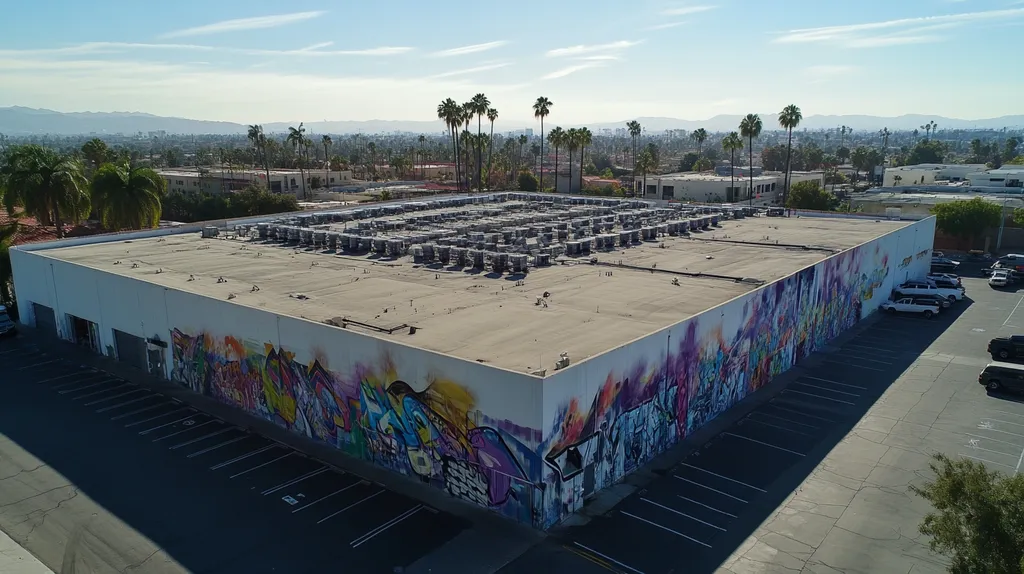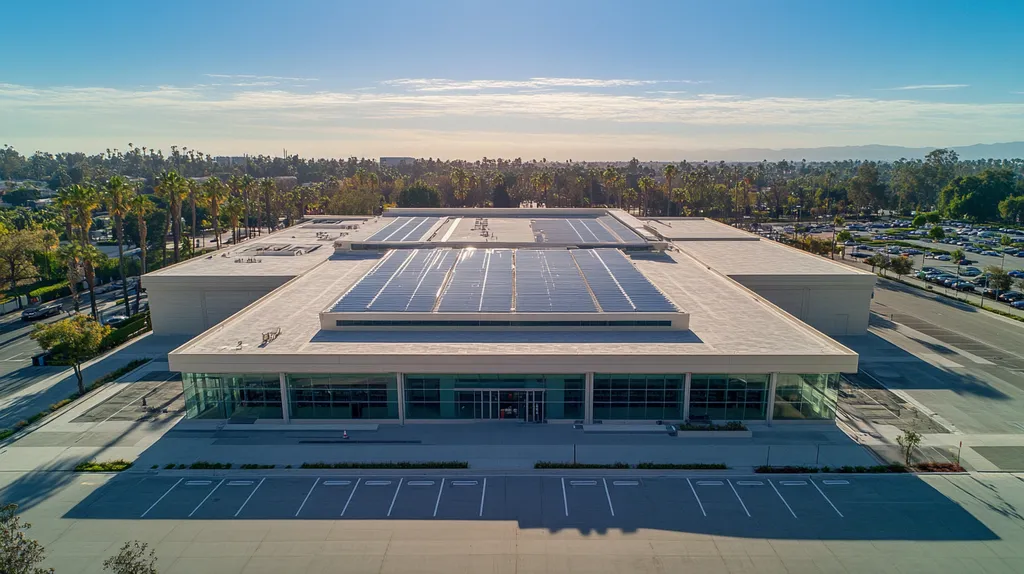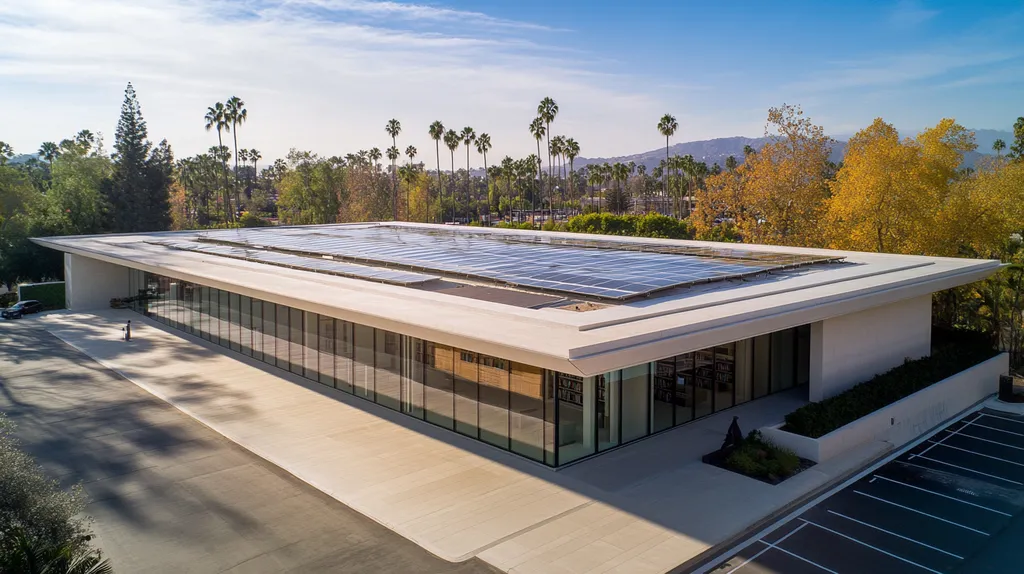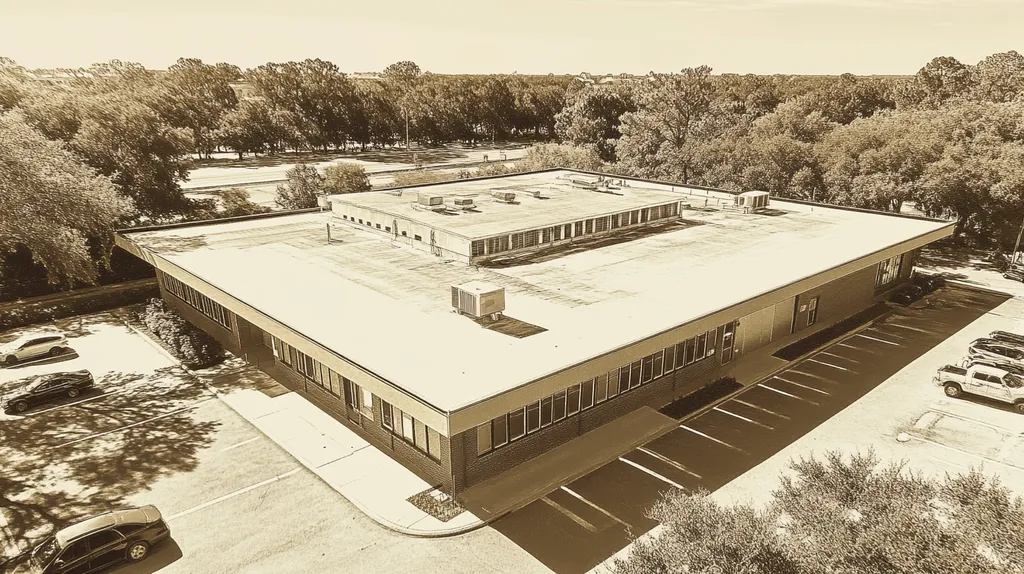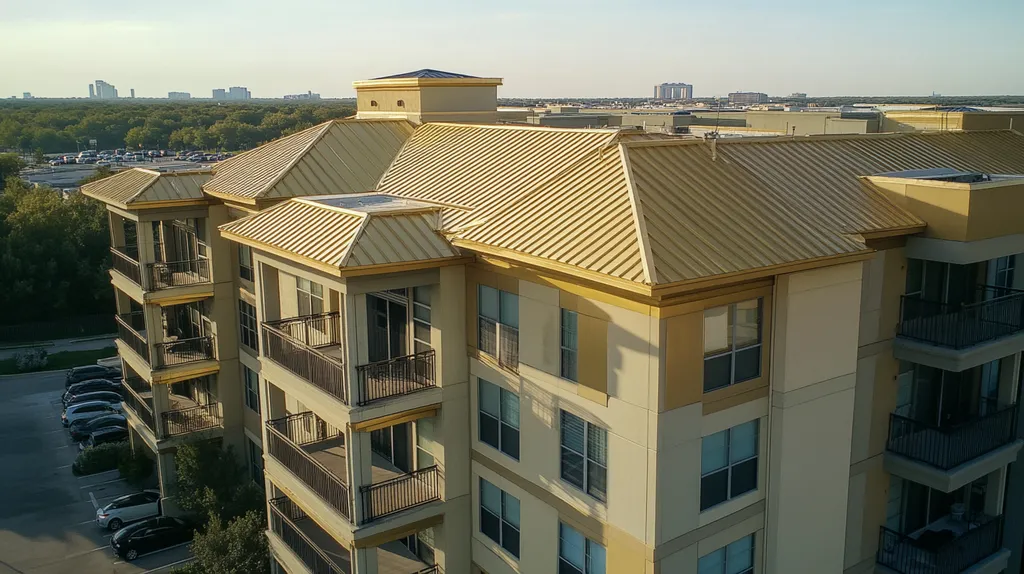Every year, commercial building owners lose millions of dollars to water damage caused by compromised roof drainage systems. When protective coatings fail or interfere with proper water flow, even a minor rainstorm can trigger catastrophic failures.
Understanding how coatings affect drainage patterns isn’t just about maintenance—it’s about protecting your entire building investment. Different coating types create distinct surface characteristics that can either enhance or impede water movement across your roof.
This comprehensive guide examines the critical relationship between coating selection and drainage performance, helping facility managers make informed decisions to prevent costly failures.
SECTION 1: THE BASICS EXPLAINED
Water damage from improper roof drainage costs commercial building owners millions annually in repairs and replacements. When protective coatings interfere with drainage patterns, even a minor rainstorm can create devastating consequences. Understanding the relationship between coatings and drainage isn’t just about maintenance—it’s about protecting your entire building investment and preventing catastrophic failures.
What It Is (In Plain Language)
Roof coatings are specialized liquid materials that create a protective membrane when applied to commercial roofs. They serve multiple purposes, from waterproofing to reflecting sunlight, but their interaction with water flow is particularly crucial.
Different coating types create distinct surface characteristics that affect how water moves across your roof. Some coatings produce smooth, hydrophobic surfaces that encourage rapid drainage, while others may create slightly textured surfaces that can slow water movement.
Acrylic coatings, while economical and reflective, can’t withstand prolonged water exposure and require specific temperature conditions for proper application. These limitations make them unsuitable for roofs prone to ponding water. (source: FacilitiesNet)
The coating’s thickness, texture, and chemical properties all influence how effectively water moves toward drains and scuppers. Understanding these characteristics helps ensure proper drainage performance.
Why It Matters (To Your Building)
Proper drainage prevents water accumulation, which can add thousands of pounds of stress to your roof structure. Just one inch of water across 1,000 square feet adds over 5,000 pounds of weight—enough to compromise structural integrity.
When drainage works correctly, it protects your building’s envelope from water infiltration. This preservation of the building envelope prevents costly interior damage, mold growth, and disruption to business operations.
Effective drainage also extends coating lifespan by preventing premature degradation. Without proper drainage, even the highest-quality coating will fail before its expected service life.
The financial impact extends beyond immediate repair costs to include increased insurance premiums and decreased property value. Protecting drainage functionality preserves both your coating investment and overall building value.
How It Works
Coating systems interact with your roof’s existing slope and drainage features to direct water movement. The coating’s surface tension and texture influence how quickly water sheets across the roof surface toward collection points.
Temperature fluctuations cause roofing materials to expand and contract, potentially affecting drainage patterns. Quality coatings maintain their properties through these cycles, ensuring consistent water flow regardless of conditions.
Properly selected coatings enhance the roof’s natural drainage capabilities by maintaining clear pathways to drains. They work in concert with tapered insulation and other drainage-promoting features to prevent water accumulation.
Regular inspection and maintenance ensure coatings continue supporting proper drainage throughout their service life. This systematic approach prevents small drainage issues from escalating into major problems.
SECTION 2: PRACTICAL APPLICATIONS
Commercial roof drainage issues cost building owners billions annually in repair and replacement costs. Without proper coating selection and application, even well-designed drainage systems can fail catastrophically. Research shows that up to 40% of all commercial roof failures stem from inadequate drainage, making proper coating selection a critical factor in protecting building assets.
Common Uses & Examples
Specialized coatings play essential roles in protecting and enhancing commercial roof drainage systems. Modern coating applications range from simple waterproofing to complex drainage enhancement solutions that actively promote water movement toward collection points.
Acrylic coatings, while cost-effective for many applications, can break down when exposed to standing water for more than 48 hours, leading to system failure. This limitation makes them unsuitable for roofs with potential ponding issues. (source: American WeatherStar)
High-build elastomeric coatings excel in areas requiring enhanced drainage performance. Their flexibility allows them to maintain integrity during thermal cycling while promoting consistent water flow patterns.
Silicone-based systems offer superior ponding water resistance and can help restore proper drainage on aging roof surfaces. Their durability makes them ideal for rehabilitating drainage patterns on deteriorated substrates.
When You Need It Most
Critical timing for coating application often coincides with early signs of drainage problems. Indicators include slow water evacuation after rainfall, visible ponding areas, or emerging leak patterns.
Preventive coating applications become crucial before severe weather seasons. This timing allows proper curing and ensures maximum protection when drainage systems face their greatest challenges.
Building modifications that affect roof loading or drainage patterns necessitate immediate coating attention. Changes in HVAC equipment placement or building use can create new drainage challenges requiring specialized coating solutions.
Aging roof systems typically need coating intervention when existing drainage patterns begin to fail. Early intervention can prevent minor drainage issues from escalating into major structural problems.
Interactions With Other Systems
Coating performance depends heavily on integration with existing drainage components. Proper coating selection must account for compatibility with drain edges, scuppers, and other water collection points.
Building movement and settling can affect how coatings interact with drainage systems. Flexible coating systems help maintain drainage integrity despite subtle changes in roof geometry.
HVAC systems and roof penetrations create unique challenges for coating applications. Strategic coating selection around these elements helps maintain proper drainage flow while protecting vulnerable transition points.
Environmental factors like UV exposure and temperature fluctuations influence how coatings affect drainage performance. Understanding these interactions ensures long-term drainage effectiveness through seasonal changes.
SECTION 3: KEY TERMINOLOGY DECODED
Technical roofing terminology often creates barriers between contractors and property owners, leading to costly miscommunications and drainage failures. When facility managers misinterpret coating specifications or drainage requirements, the consequences can be devastating. A single misunderstood term can result in inappropriate coating selection, compromised drainage, and hundreds of thousands in water damage.
Essential Terms Explained
Drainage capacity represents how efficiently a roof system channels water to designated collection points. This includes not just the physical slope, but how coatings interact with existing drainage patterns to prevent water accumulation.
Ponding describes standing water that remains on a roof for more than 48 hours after rainfall. This condition stresses structural components and accelerates coating degradation, particularly with non-ponding-resistant materials.
Silicone coatings offer superior resistance to ponding water while maintaining excellent UV protection and elasticity, making them ideal for problematic drainage areas. Their unique chemical properties allow them to withstand prolonged water exposure without breaking down. (source: FacilitiesNet)
Surface tension describes how water molecules interact with coating surfaces. Higher surface tension causes water to bead up rather than sheet across the roof, potentially creating drainage obstacles.
Industry Jargon Translated
Positive drainage refers to roof designs that eliminate standing water within 48 hours. This concept directly influences coating selection, as some materials break down under prolonged water exposure.
Substrate compatibility indicates how well a coating bonds with the underlying roofing material. Poor compatibility can lead to coating failure and compromised drainage patterns.
Mil thickness measures coating depth in thousandths of an inch. Proper mil thickness ensures adequate protection while maintaining designed drainage slopes.
Wind uplift resistance describes a coating’s ability to remain adhered during high winds. This factor becomes crucial when considering drainage patterns near roof edges and corners.
Measurement & Units Simplified
Slope calculations use a rise-over-run ratio, typically expressed as ¼:12, meaning ¼ inch of height increase per 12 inches of horizontal distance. This measurement directly affects how quickly water moves across coated surfaces.
Coverage rates indicate how many square feet one gallon of coating material will protect. These rates vary based on substrate texture and required mil thickness.
Tensile strength measures a coating’s resistance to tearing, typically expressed in pounds per square inch (psi). Higher tensile strength helps maintain drainage integrity during thermal cycling.
Elongation percentage shows how far a coating can stretch without breaking. This measurement becomes critical in maintaining continuous protection over moving substrate joints that affect drainage.
SECTION 4: DECISION FACTORS
Strategic decisions about roof coatings can mean the difference between effective drainage and catastrophic water damage. Poor coating choices lead to premature system failure, structural deterioration, and extensive repair costs that can reach hundreds of thousands of dollars. Understanding the interplay between coating selection, drainage performance, and long-term durability helps facility managers protect their building investments while optimizing maintenance budgets.
Cost Considerations
Initial coating expenses represent only a fraction of total system costs. Premium coatings may command higher upfront prices but often deliver superior drainage performance and reduced maintenance requirements over their service life.
Labor costs vary significantly based on coating complexity and application requirements. Some high-performance coatings demand specialized equipment and certified installers, while others allow for more straightforward application methods.
Roof coatings can play an important role in preventing and repairing damage caused by ponding water, but should never be viewed as a replacement for proper drainage systems. Selecting appropriate materials helps protect against water accumulation while improving overall energy efficiency. (source: SmartSeal)
Emergency repairs and business interruptions from coating failures often exceed the cost difference between standard and premium products. Investing in quality materials that enhance drainage typically proves more economical over the full system lifecycle.
Performance Trade-offs
Coating thickness significantly impacts drainage characteristics. Thicker applications provide enhanced protection but may alter existing drainage patterns, while thinner coatings maintain original flow paths but offer reduced durability.
Surface texture affects both water movement and coating adhesion. Smoother finishes promote rapid drainage but may compromise grip strength, while textured surfaces enhance adhesion but can slow water evacuation.
Temperature resistance directly influences long-term drainage performance. Coatings must maintain their properties through extreme temperature cycles to prevent cracking or separation that could disrupt water flow.
UV stability plays a crucial role in sustained drainage effectiveness. Materials that resist UV degradation maintain their drainage-promoting characteristics longer, particularly in exposed roof areas.
Lifespan & Durability Factors
Environmental exposure significantly impacts coating longevity. Systems must withstand local weather patterns, pollution levels, and temperature extremes while maintaining consistent drainage performance.
Substrate movement and building settling create ongoing challenges. Durable coatings flex with structural shifts without compromising drainage patterns or developing cracks that could allow water infiltration.
Chemical resistance becomes critical near mechanical equipment. Coatings must withstand exposure to HVAC condensation, exhaust residues, and maintenance chemicals while preserving drainage functionality.
Regular maintenance requirements vary by coating type. Some systems demand frequent inspections and touch-ups to maintain drainage effectiveness, while others provide consistent performance with minimal intervention.
Impact resistance affects long-term drainage reliability. Coatings must withstand foot traffic, dropped tools, and minor impacts without developing low spots that could impede water flow.
SECTION 5: COMMON CHALLENGES
Drainage failures in coated commercial roofs cause millions in damage annually, with a single incident often exceeding $100,000 in repairs. Common challenges like coating degradation, ponding water, and inadequate drainage patterns threaten both roof integrity and building operations. Understanding these issues is critical, as even minor drainage problems can escalate into catastrophic failures within a single storm season.
Frequent Problems & Solutions
Water ponding remains the leading cause of premature coating failure, particularly in areas with poor drainage design. Just two inches of standing water can add over 10,000 pounds of weight per 1,000 square feet, stressing both the coating and underlying structure.
Coating shrinkage and separation frequently disrupt designed drainage patterns, creating new low spots that trap water. Regular inspections during rainfall events help identify these developing issues before they compromise the entire system.
FacilitiesNet reports that while acrylic coatings fail under ponding conditions, silicone coatings excel at resisting long-term water exposure while maintaining UV protection and elasticity. (source: FacilitiesNet)
Surface contamination from airborne debris, biological growth, and chemical deposits can alter coating surface characteristics. Professional cleaning and recoating of affected areas helps restore proper drainage flow.
Warning Signs To Watch For
Discoloration patterns after rainfall indicate areas where water movement has slowed or stopped. These patterns often appear before visible coating damage, providing early warning of developing drainage issues.
Coating blisters and delamination signal trapped moisture beneath the surface. Immediate investigation and repair prevents these localized problems from spreading and compromising broader drainage patterns.
Changes in drain outflow volumes or timing suggest developing blockages or alterations in drainage paths. Regular flow testing helps identify these shifts before they cause significant ponding.
Interior staining or moisture readings indicate water has already breached the coating system. Thermal imaging and moisture mapping can trace water migration paths to identify drainage failure points.
Preventative Approaches
Scheduled inspections during peak rainfall periods reveal how water actually moves across coated surfaces. This real-world observation often identifies drainage issues that remain hidden during dry weather inspections.
Strategic coating selection based on specific drainage challenges prevents common failure modes. Areas prone to ponding require materials specifically engineered to withstand prolonged water exposure.
Regular drain cleaning and maintenance preserves designed flow patterns. Even minor debris accumulation can redirect water movement, creating new stress points in the coating system.
Documentation of drainage patterns helps track changes over time. Comparing current conditions to baseline measurements enables early intervention before problems escalate into emergencies.
Proactive recoating of high-stress areas maintains drainage effectiveness. Areas around drains, low spots, and equipment curbs often need attention before visible deterioration occurs.
SECTION 6: NEXT STEPS & RESOURCES
Commercial roof drainage failures cost property owners millions annually in structural repairs and interior damage. When drainage systems fail due to improper coating choices, even minor rainstorms can trigger catastrophic consequences. Making informed decisions about coatings requires understanding critical questions to ask, knowing relevant standards, and accessing reliable educational resources.
Questions To Ask Providers
Coating selection directly impacts drainage performance and requires thorough provider vetting. Start by requesting detailed drainage analysis for your specific roof configuration and climate conditions.
Ask providers to explain how their recommended coating system will maintain or enhance existing drainage patterns. Request documentation of coating performance under various weather conditions and evidence of long-term durability.
Inquire about specific application requirements that could affect drainage characteristics. Understanding temperature restrictions, cure times, and surface preparation needs helps prevent installation-related drainage issues.
Verify warranty coverage specifically related to drainage performance. Many standard warranties exclude damage from ponding water, making it crucial to understand these limitations before selection.
Industry Standards & Guidelines
Inadequate drainage leads to water accumulation, causing leaks and potential interior damage that can compromise structural stability and create hazardous conditions. Long-term consequences include mold growth, roofing material deterioration, and extensive repair costs. (source: Instacoat)
Follow ASTM D6083 standards for acrylic coating applications, which specify minimum performance requirements for water resistance and elongation. These benchmarks help ensure coating systems maintain drainage effectiveness.
Consult FM Global Property Loss Prevention Data Sheets for drainage design criteria. These guidelines provide specific recommendations for drain spacing, sizes, and coating compatibility.
Reference NRCA technical bulletins for coating application best practices. These documents outline critical factors affecting drainage performance and long-term reliability.
Further Learning Simplified
Access educational resources through professional organizations like RCMA and NRCA. Their technical libraries offer detailed guidance on coating selection and drainage considerations.
Participate in manufacturer training programs that focus on drainage-specific applications. These sessions provide hands-on experience with different coating types and their drainage characteristics.
Review case studies of successful drainage solutions in similar building types. Understanding real-world applications helps identify effective strategies for your specific situation.
Connect with local roofing professionals through industry associations. These relationships provide ongoing access to current best practices and emerging coating technologies.
The Bottom Line
Commercial roof drainage failures trigger over $1 billion in annual damages across North America, with coating-related issues accounting for 40% of these catastrophic events.
The relationship between coatings and drainage remains one of the most critical yet frequently misunderstood aspects of commercial roofing systems.
Proper coating selection and application can dramatically enhance drainage performance, extending roof life while protecting structural integrity.
Conversely, poor choices in coating materials or application methods can transform minor drainage issues into major structural threats within a single storm season.
As weather patterns become more extreme and building codes more stringent, understanding this crucial relationship becomes increasingly vital for protecting commercial building investments.
FREQUENTLY ASKED QUESTIONS
Q. How do coatings impact drainage on a commercial roof?
A. Coatings can alter how water flows across your roof. Certain coatings might create slick surfaces to enhance drainage, while others may have textures that slow water movement. Understanding these effects helps prevent water accumulation and costly repairs.
Q. What coatings are most effective for an industrial roof?
A. High-build elastomeric and silicone coatings are among the best choices for industrial roofs. They provide durability and resistance to standing water, making them ideal for roofs prone to ponding. Selecting the right coating can extend the roof’s service life and enhance drainage.
Q. What does ponding mean for commercial roofs?
A. Ponding refers to water that remains on the roof for more than 48 hours. This condition can lead to coating failure and structural stress. Effective drainage solutions are essential to prevent ponding and its associated issues.
Q. How can I choose the right coating for drainage issues?
A. Assess your roof’s drainage characteristics and common weather patterns. Then, consult with coating providers to evaluate options that specifically address drainage needs. Selecting coatings resistant to water accumulation will enhance overall performance and longevity.
Q. What are common signs of drainage problems on my roof?
A. Look out for visible ponding, discoloration, and water stains. Blisters or separation in the coating can indicate trapped moisture. Identifying these signs early can help remediate issues before they escalate into more significant problems.
Q. How often should I inspect my commercial roof for drainage issues?
A. Regular inspections should occur at least twice a year, ideally in spring and fall. Additionally, inspections after extreme weather events can help reveal any new drainage concerns. Prompt action can prevent minor issues from developing into major repairs.
Q. What resources can help in selecting roof coatings?
A. Look for guidance from professional organizations like the NRCA or RCMA. They offer resources and publications on coating selection. Manufacturer training sessions can also provide valuable insights into appropriate products for specific roofing challenges.

